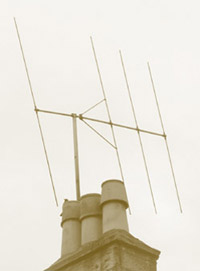 A
four-element Band I aerial similar to the one Albert helped erect
fifty-odd years ago.
A
four-element Band I aerial similar to the one Albert helped erect
fifty-odd years ago. |
|
By
Albert Wright
When I was demobbed from the army after the war I returned to my
pre-war job building railway wagons, but soon I found a better job.
I became employed as a carpenter by a firm of builders and property
repairers in Doncaster. As well as building public houses, schools,
etc., the firm did a lot of property maintenance in and around the
town centre.
Sometime in the late nineteen forties-I can't remember the exact
date-I was called into the office. I had just finished my last job,
which had been renewing the sash cords in several old terraced houses.
The foreman handed me a slip of paper on which was written a name
and an address. When I read the address I recognised it as being
a wireless shop about half a mile away from the depot where I worked.
The foreman said 'You are all right climbing, aren't you, because
he wants you to fix something to his chimney. I don't know what
it is. Take Charlie with you, and some ladders, and go and see what
he wants doing.' So after putting some pole ladders and my tool
bag onto the handcart we set off for the shop.
On arriving there I opened the gate in the back wall and went into
the yard. There laid out on the concrete yard was something I had
never seen before or could even start to guess what it was. Bending
down over this object was the shop owner. He straightened up and
came towards us with a smile on his face. As he approached I said
'Well, what is it?' I was told that it was an aerial and with it
he hoped to get television signals from Birmingham. Apparently the
BBC had just built a transmitting station at a place called Sutton
Coldfield. This was 75 miles from Doncaster, but the shop owner
thought it might be just possible to receive television signals
even at that distance.
"And you want this thing fixed onto the chimney stack?"
I asked. On my enquiring just how he was expecting it to be fixed
to the chimney, he produced several sheets of paper on which were
printed diagrams showing just how to do it. He showed me a pile
of brackets, coils of wire, and a lot of bits and pieces. I suggested
that a cup of tea would help while I read the instructions and got
things sorted out. I will try as well as my memory will allow to
describe this aerial which the shop owner had, he told me, spent
two days putting together and was now complete except for some cable
to be coupled up. First there was a wooden pole, two inches in diameter
and twelve feet long. It was quite heavy and seemed to be some kind
of foreign hardwood. On top of the pole was an aluminium fitting
with a half-round indentation across the top. This was ready to
receive an aluminium crossbar. The crossbar had a small hole about
two thirds of the way along on the top. There was a cast aluminium
cap with a lug on it that fitted into the hole. The cap was screwed
down to the mast fitting, which had threaded holes for the bolts.
When the cap was screwed down the lug prevented the cross bar from
turning round. The cross bar would be about eight feet long and
had, I think, four vertical rods attached. These were also about
eight feet long.
For a 1949 aerial catalogue click
here.
Continued 
|

